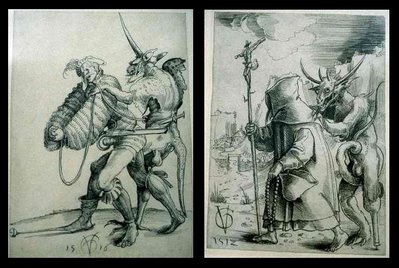

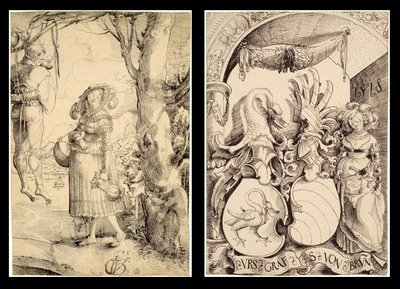
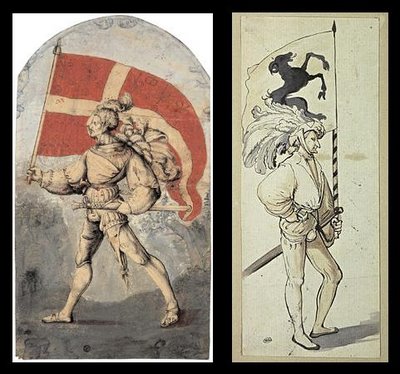

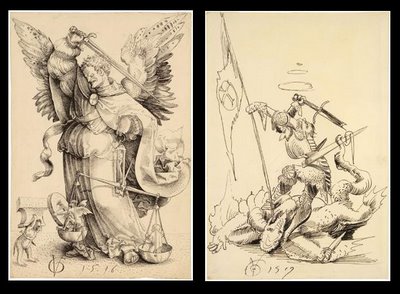

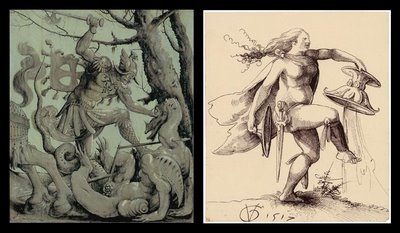


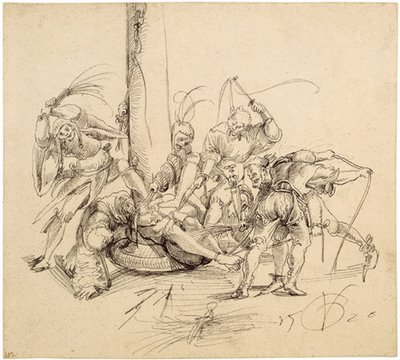
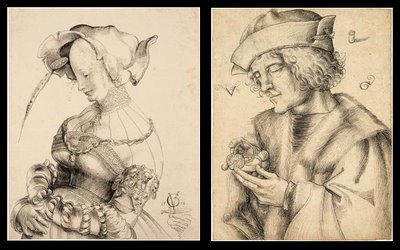

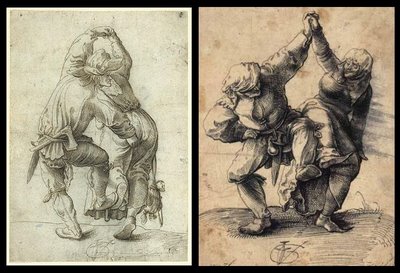
Urs Graf (1485-?1528) was the most important artist of the early renaissance from German Switzerland. He was active in Basel and Zurich from about 1507 until his mysterious disappearance from Basel in 1527.
Graf was a member of the Goldsmiths Guild, a die-cutter, woodblock book illustrator, stain glass designer and painter, engraver, and a mercenary who periodically escaped his artisan life for military adventures in Italy. He produced the world's first etching print in 1513 (not shown) and pioneered the white-line woodblock technique (first image below).
By all accounts Graf's was something of a tumultuous life, frequently involving legal problems from fighting, beating his wife and consorting with prostitutes. He fled Basel for a year in 1518 after an attempted murder.
Through it all Graf produced unique artworks reflecting the violence and social circumstances in which he was immersed. These lively prints and drawings incorporate elements of fantasy or the grotesque and erotic (or at least perverse) but are frequently tinged with a satirist's sense of humour. Conversely, his legacy also includes a sizeable number of purely religious prints and book illustrations. Graf almost always signed his drawings, a practice which helped establish sketch work as an individual artistic discipline rather than a mere transitional process.
Urs Graf was certainly influenced by his more famous contemporary, Albrecht Dürer, and in fact copied at least one of Dürer's prints; but overall Graf pursued his own style which has influenced latterday artists such as surrealist Kurt Seligman (last image below: 'Homage to Urs Graf') and also Otto Dix.
Unfortunately, there are very few large Graf images available online. The great majority of the images above (everything was uploaded at full size so click the images to enlarge them) come from the Kunstmuseum in Basel.
Biographic and/or images can be found here: i, ii, iii, iv, v, vi, vii, viii, ix, x, xi, xii, xiii, xiv, xv, xvi, xvii [Italian], xviii [German], xix [Russian], xx.


These dagger prints were engraved by Graf - they were made from
the early drafts by Hans Holbein for his famous 'Dance of Death' series.
the early drafts by Hans Holbein for his famous 'Dance of Death' series.
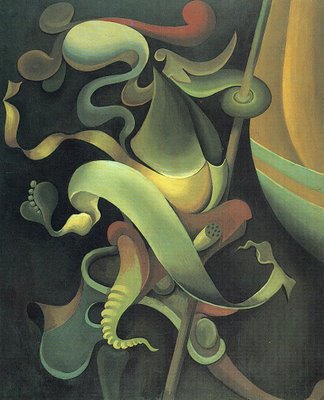
The detail in Graf's work is astounding. Thanks for bringing these to light.
ReplyDeleteThe information are impressive,
ReplyDeletevivid drawings!
I adore this site! It is one of my very favorites but it is utterly exhausting. Scrolling through these images, I feel like I am standing under Niagara Falls with a paper cup. Some day I am going to take 5 years off of work and give these lovely pictures the attention they deserve.
ReplyDeleteCheers.
ReplyDeleteDavid, this might seem kind of crazy but I don't actually get to sit back and admire much of the material until days after it has been posted.
Finding/trimming/cleaning/research tends to blur out contemplation of the underlying work. I end up scrolling the site many times during the week or so that a post remains on the front page to get my own 'moneys worth'.
{David's site is none too shabby either}
Wirklich eine schöne Sammlung von Werken des Urs Graf. Urs Graf ist ja nicht nur als Künstler interessant. Das Söldnerleben hat er ja aus eigener Erfahrung gekannt.
ReplyDeleteNice pictures! I used the one with the Danse Macabre-motif in my blog and linked to your post. Looking forward for more of the same sort…
ReplyDeleteThanks for posting these - a graphic treasure trove for a lifelong Durer fan. Any suggestions for similar graphic journalists of the same era? I'm a contemporary illustrated reporter and am always on the hunt for inspiration. Cheers!
ReplyDeleteHello,
ReplyDeleteBy any chance do you know a book or an edition that groups together this pictures?
Best regards
Guillaume
Guillaume, I don't know *if* there are any illustrated books featuring Urs Graf, but I'm not very knowledgeable about the publishing history. I suppose you might want to start looking on worldcat.org and/or write to a gallery specialising in Renaissance prints. Good luck!
ReplyDelete